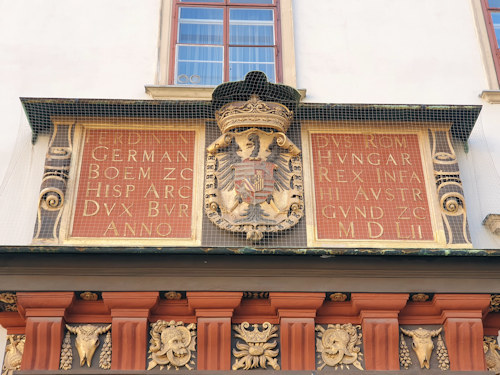
It’s a gate. But not of the wooden fence and latch variety. The imposing russet, black and gold Schweizertor (Swiss Gate) first allowed access to the Hofburg palace over 470 years ago.
- Built 1552-1553
- Features the crest and insignia of Emperor Ferdinand I
- Named after the 18th-century Swiss Guard
- Book a guided tour* of the Hofburg area
- See also:
The Swiss Gate

(The “Swiss Gate” took its moniker from the same-named guards during the reign of Maria Theresa)
Hard to imagine how many people must have passed through the Schweizertor that now forms an arched gateway between two notable courtyards in the former Hofburg home of the Habsburgs.
On one side you have the Schweizerhof, which contains the Schatzkammer (crown jewels) and the Hofburgkapelle (court chapel). This enclosed area also acted as a movie location in the film, Corsage. I believe the rear of the Schweizertor might even be visible in a shot.
On the other side you have the Innere Burghof, which contain major palace tracts and the giant monument to Emperor Franz II/I).
The gate went up in the early 1550s on the orders of Emperor Ferdinand I (1503-1564). His name appears on the inscription above the front, and Roman numerals suggest 1552-1553 as the date of construction.
A second Emperor Ferdinand I (1793-1875) also made an appearance in Austrian history. The first one was Emperor of the Holy Roman Empire, the second one head of the Austrian Empire. (It gets confusing.)

(Close up of the crest and inscription)
The court of the time sadly failed to keep digital planning records, but it seems one Pietro Ferrabosco was chiefly responsible for the design and the ceiling frescoes that mark the gate. Ferrabosco worked as an architect and/or a painter on various significant Habsburgian projects.
At the time, of course, the Schweizertor would have been an entrance rather than a connecting passageway. What is now the Schweizerhof courtyard once formed the main part of the Hofburg.
The echoes of a Roman triumphal arch, the unusual (if not entirely original) colours, the emblems, and frescoes certainly give the gate a unique and photogenic look.
Those emblems and frescoes in particular offer some insight into Habsburg history. The paintings in the passageway, for example, are a nod to various Habsburg dominions under Ferdinand’s aegis.

(The ceiling frescoes inside)
And the gold chain surrounding the royal crest on the front? This is the chain of the order of the Golden Fleece, a chivalric order of knights created in 1430 and with a strong Habsburg connection.
(The Imperial Treasury contains some of the order’s most precious accoutrements.)
A plaque on a side wall gives a brief overview of the history of the Schweizerhof and gate. It also notes that the term Schweizertor only came into use around the time of Empress Maria Theresa (1717-1780), when the Swiss Guard watched over the complex for a number of years.
The soldiers came to Vienna in the service of Maria Theresa’s husband, Franz Stephan, though the guard was then dissolved in the reign of their son, Emperor Joseph II.

(Guards march through the Schweizertor on a postcard sent around 1908; produced by Wolf, Vereinigte Kunstanstalten, Vienna; Wien Museum Inv.-Nr. 205143; excerpt reproduced with permission under the terms of the CC0 licence)
If you walk through the Schweizertor, across the Schweizerhof and on to Josefsplatz square, you’ll find an equestrian monument to the very same Joseph.
How to get to the Schweizertor
Simply follow the travel tips for the Hofburgkapelle, which is just the other side of the gate. You should also pass the Schweizertor on a stroll through the Hofburg.
Address: Hofburg-Schweizerhof, 1010 Vienna